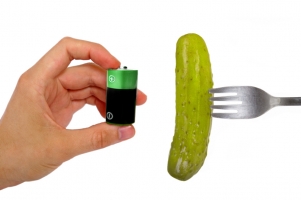From Pickles and Power Supplies to Hard Drives and Hosiery
Professor Creates Index to Identify Industry Relationships

David Bryce, BYU assistant professor of strategy.PROVO, Utah – Sep 30, 2009 – If online dating sites can successfully match up two people that have never met, why can't the same concept be used to make matches in the business world? One professor from Brigham Young University's Marriott School of Management thinks it can.
Using data from the U.S. Census Bureau, David Bryce, assistant professor of strategy, developed an index that tells how much two industries have in common — setting up what you might call a manufacturing matching service. Bryce's system helps identify industries that could potentially share knowledge, processes and other synergies.
"This tool will be particularly useful for researchers studying corporate diversification," Bryce says. "With the index, a researcher can study how firms evolve over time in terms of the activities they take on."
While many of the most related industries on the index are fairly obvious — such as the pairing of paving mixtures with ready-mixed concrete — the index also uncovers some relationships that aren't so obvious. For example, it seems pickles and batteries have more in common than you might think; their two categories, "primary batteries" and "pickles, sauces and dressings," are related in the 99th percentile.

Pickles and batteries have more in common than you might think; their two categories, “primary batteries” and “pickles, sauces and dressings,” are related in the 99th percentile."This suggests that there is some knowledge in making pickles that also applies to making batteries," Bryce says. "It could also be that both industries have similar distribution channels, markets or manufacturing processes."
Bryce developed the index by using census data in a series of equations that considers how many firms operate in a single industry or group of industries. The result was a list of more than 80,000 pairs and a scoring of their relationships. Researchers looking at the behavior of manufacturing businesses can use these pairs to help predict the success of a firm that has recently entered a new market.
"In this kind of research, it's not always clear what's related and what isn't," Bryce says. "The index fills that gap by providing a way to measure the distance between two industries."
The index does more than identify manufacturing relationships. After looking at more than 1,700 manufacturing plants, Bryce discovered the index was able to predict how companies had entered new markets.
"The index has high predictive capacity because it can actually forecast whether a firm will enter a market by building a new business from the ground up or by buying an existing one," Bryce says. "This makes sense because only firms that are already knowledgeable about a related industry will build a business directly, while others will acquire."
Though the study is intended to help academic researchers, Bryce says there are plenty of practical business applications. A manager who is wondering how to grow a company could look at the index and see not only what other activities are related but also the relative strength of that relationship. This can be especially useful as companies initially explore growth opportunities because the index may suggest previously unconsidered industries.
"It can open up possibilities when used in a brainstorming exercise," Bryce says. "You would not want to rely exclusively on the index, but it can suggest avenues of growth for a manager looking to diversify a company in other markets."
For example, computer storage devices and women's hosiery are highly related, according to the index. In this case, the link is a third industry, plastics foam products, which is related to both at nearly the hundredth percentile.
Does that say we'll see Maxtor and L'eggs coming out of the same company?
"Maybe not," Bryce says, "but if foam products represented a large percent of manufacturing costs for both industries, then it might actually be reasonable to share common resources."
And what about the least related industries? The index shows that ice manufacturers might avoid getting into Schiffli machine embroidery, a type of textile made with a special threading machine. The two scored near the zero percentile with a z-score of -7.0.
Bryce coauthored the study with Sidney Winter, professor of management at the University of Pennsylvania's Wharton School. The findings were published in an article titled "A General Interindustry Relatedness Index" in the September issue of the academic journal Management Science.
The Marriott School is located at Brigham Young University, the largest privately owned, church-sponsored university in the United States. The school has nationally recognized programs in accounting, business management, public management, information systems and entrepreneurship. The school's mission is to prepare men and women of faith, character and professional ability for positions of leadership throughout the world. Approximately 3,000 students are enrolled in the Marriott School's graduate and undergraduate programs.
Media Contact: Joseph Ogden (801) 422-8938
Writer: Dustin Cammack



